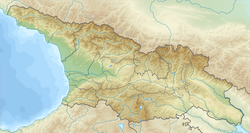Gori
გორი | |
|---|---|
City | |
|
From top: Town Hall, Gori Fortress, Gori Cathedral, FC Dila Stadium, Panoramic view to Gori | |
| Coordinates: 41°58′0″N 44°06′0″E / 41.96667°N 44.10000°E | |
| Country | |
| Region | Shida Kartli |
| Municipality | Gori |
| Area | |
| • Total | 16.85 km2 (6.51 sq mi) |
| Elevation | 588 m (1,929 ft) |
| Population (January 1, 2024)[1] | |
| • Total | 42,596 |
| • Density | 2,500/km2 (6,500/sq mi) |
| Time zone | UTC+4 (Georgian Time) |
| Postal code | 1400 |
| Climate | Cfb |
| Website | www |
 | |
Gori (Georgian: გორი [ˈɡoɾi]) is a city in eastern Georgia, which serves as the regional capital of Shida Kartli. It is located at the confluence of two rivers, the Mtkvari and the Liakhvi. Gori is the fifth most populous city in Georgia. Its name comes from the Georgian word gora (გორა), meaning "heap", "hill",[2] or "mountain".
A settlement known here from the Hellenistic period, with the Gori Fortress built at least in 7th century, it received town status in the 12th century. Gori was an important military stronghold in the Middle Ages and maintains a strategic importance due to its location on the principal highway connecting eastern and western parts of Georgia. In the course of its history, Gori has been invaded by the armies of regional powers several times. The city was occupied by Russian troops during the 2008 Russo–Georgian War.
Gori is also known as the birthplace of communist revolutionary and Soviet politician Joseph Stalin, ballistic missile designer Aleksandr Nadiradze, and philosopher Merab Mamardashvili.
- ^ "Population by regions". National Statistics Office of Georgia. Retrieved 28 April 2024.
- ^ E.M. Pospelov, Geograficheskie nazvaniya mira (Moscow, 1998), p. 121.








